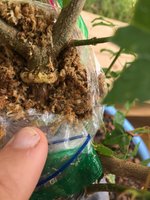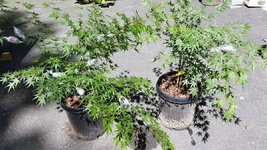D
Deleted member 32750
Guest
So about 3 weekends ago, I started air layers on 2 Japanese Red Maple seedling nursery plants and a field grown trident maple that I bought last year. This is my first attempt at propagating plants by air layer so I'm not entirely sure how to to know if the technique is successful and the plants are rooting until I actually see the roots in the sphagnum moss.
Well I decided to take a little peek into the bags this morning to see how it looks and I noticed that the Red Maples don't appear to have started doing anything yet, but the Trident has some movement going on.
I took a picture of the Trident and I was hoping if someone who is experienced with layering can tell me if this is a good sign that the plant is starting to root?

I started the layer by cutting a ring into the bark and then I used a knob cutter to cut a ring into the wood as directed by Peter Warren's book "Bonsai" then I applied Clonex with a Q-tip around the top of the Layer
For this tree I took it a step further and put a wire tourniquet on the exposed wood as well. Maybe a little over kill but I wanted to experiment.
But nonetheless, I am observing something in this tree that has the tourniquet and so far nothing in the two red maples that don't have it.
Well I decided to take a little peek into the bags this morning to see how it looks and I noticed that the Red Maples don't appear to have started doing anything yet, but the Trident has some movement going on.
I took a picture of the Trident and I was hoping if someone who is experienced with layering can tell me if this is a good sign that the plant is starting to root?

I started the layer by cutting a ring into the bark and then I used a knob cutter to cut a ring into the wood as directed by Peter Warren's book "Bonsai" then I applied Clonex with a Q-tip around the top of the Layer
For this tree I took it a step further and put a wire tourniquet on the exposed wood as well. Maybe a little over kill but I wanted to experiment.
But nonetheless, I am observing something in this tree that has the tourniquet and so far nothing in the two red maples that don't have it.



